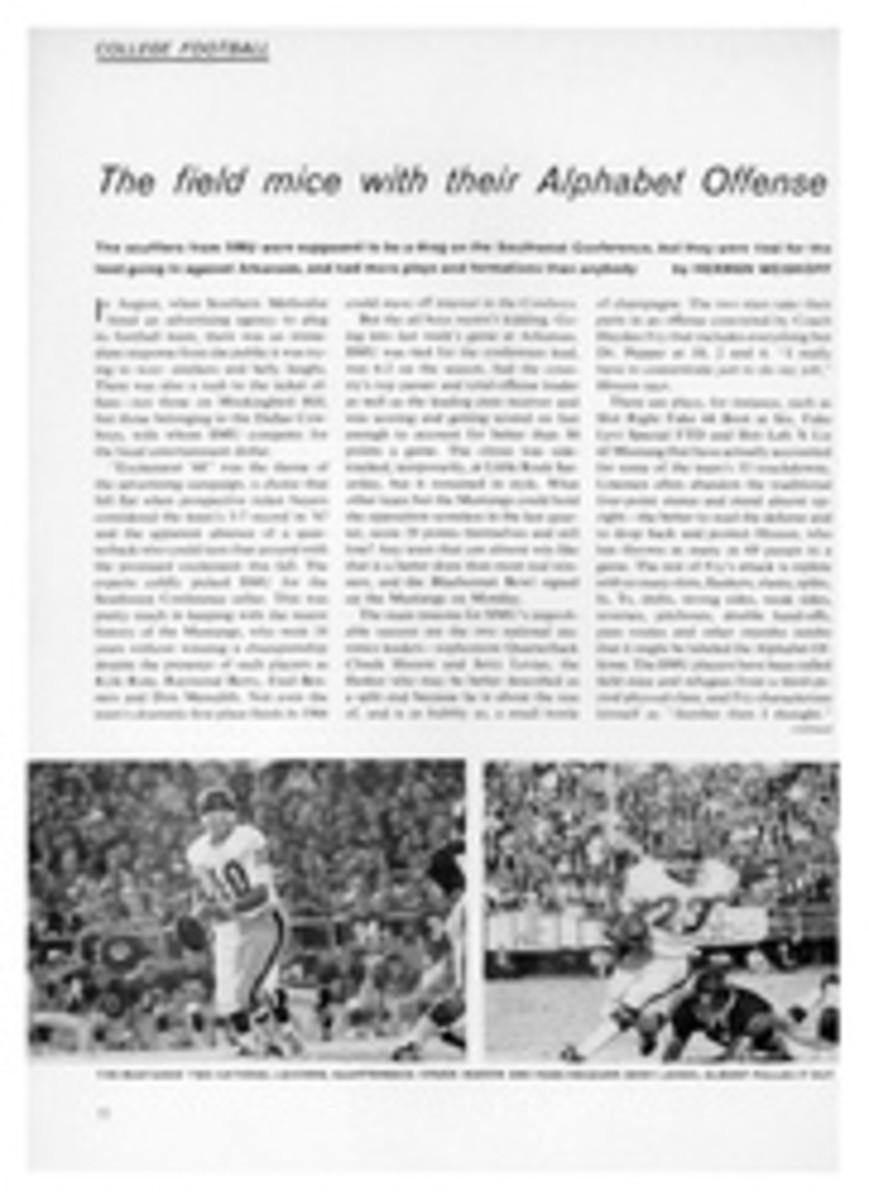
A happy hunting ground—for fishermen
In late fall, when the tamaracks are orange and gold along the western slope of the Continental Divide, most people come to the Flathead National Forest in Montana to hunt. They are rarely disappointed, because some of the finest hunting in North America is there.
The forest's more than 2‚Öì million acres are home to one of the nation's major elk herds, to moose, mule deer and white-tails. The mountains, which rise to more than 9,000 feet, are studded with mountain goats and bighorn sheep. Black bears share their browse with the country's largest concentration of grizzlies outside Alaska. Bobcats, mountain lions, Canada lynx, coyotes and wolverine roam the backcountry. Grouse—ruffed, blue and Franklin's—are everywhere, along with golden-mantled squirrels and snow-shoe rabbits.
With such a surfeit of game, it is not surprising that hunters from every part of the nation head for the area in fall. What is surprising is that they are not outnumbered by anglers, because the fall fishing in the Flathead National Forest is even better than the hunting. From late September until the first big snows in November, the streams and tributaries of the Flathead River offer what may well be the best angling for cutthroat trout, whitefish and Dolly Varden trout in the country.
Anglers have been fishing the main waters of the Flathead for decades, and a 50-mile stretch of the river above Columbia Falls to Flathead Lake is nationally recognized as a blue-ribbon trout stream. But the best-known sections of the river—those stretches which flow near roads and are accessible by car and camper—while certainly outstanding by average measures, are only average when compared to the fishing waters deep in the forest, beyond the roads and the tourist cabins and the wayside stands.
There in the wilderness, beneath the awesome 1,000-foot-high escarpment of the Chinese Wall, the Middle Fork of the Flathead River rises on the west slope of the Continental Divide. The waters flow through remote woods and glaciated canyons, over rocks 750 million years old, along paths carved first when the ice melted from the valleys 12 million years ago. Between the river's source and Bear Creek, where it emerges from the wilderness to form the southern boundary of Glacier National Park, the Middle Fork passes through some of the most primitive reaches of the Flathead National Forest and links together a network of streams and riverlets filled with fish.
And the fish are big. Twenty- to 25-pound Dolly Vardens are not unusual in these waters. Each year uncountable numbers of such trophy-sized fish migrate here to spawn, traveling 100 miles or more from the river's eventual end in Flathead Lake. But Dolly is not the only heavyweight in the Forest. High in the mountains, in tiny snow-rimmed lakes tucked away among cliffs and ramparts, the rainbow trout grow at least as big and certainly as sassy. When it comes to battle, the Middle Fork's whitefish and kokanee salmon are no slouches either. Both are fall and winter spawners and are most abundant in the forest's waters at this time of year. But the fall fishing favorite and champion of the wilderness, though definitely a lightweight contender, is the cutthroat trout. It is a lightweight only on the scales.
Like the rainbow, the cutthroat is a native Westerner, but unlike its Rocky Mountain cousin, it has stuck close to home. There are no cutthroat trout in the Eastern U.S., which is why so few anglers on the flat side of the Rockies know the fish, and even inside its original range, rainbows and other introduced fish have taken over many of the cutthroat's native streams. As anyone who has ever caught one—or better still, eaten one—knows, among trout the cutthroat, in spite of its inelegant name and unpublicized fame, is perhaps the most distinguished of all.
It is certainly the most colorful. Its silver body is spotted with bright black polka dots, and its sides are a gaudy, glistening crimson. It flaunts its trademark—a pair of crescent-shaped red slashes—under its chin. As lively in action as in appearance, the cutthroat combines the quickness and spirit of the rainbow with the persistence and pugnacity of the Dolly Varden. And if such a combination is not recommendation enough, the cutthroat can also claim the sweetest and most succulent flesh of all the trout. When the fish is broiled on an open fire alongside a mountain stream, the taste alone more than justifies the difficulties of getting to cutthroat country.
There are difficulties. A fall fishing trip into the Flathead National Forest is never an ordinary jaunt. It can, in fact, become a rather extraordinary experience when nature chooses to make it so. Mountain temperatures rise and fall in autumn with schizophrenic frequency. A sudden mountain snow storm can turn a golden afternoon into an arctic evening. Heavy rain, which may begin and end without warning, can wash away a trail in a few minutes or mire it in mud.
Even when the weather is fair and the trails are good, getting into the forest involves somewhat more than a hop, skip and a jump. It may mean an all-day pack on horseback simply to reach base camp. From there, getting to specific streams may involve any number of shorter packs and perhaps a night on the trail. There are no hot-dog stands along the way, nor is an angler likely to run into traffic. But he can run into trouble if he tackles such a trip on his own, and fishing guides in the fall, unfortunately, are about as scarce as silver quarters.
Although a number of outfitters operate in the Flathead National Forest, at this time of year most of them concentrate on hunting, which is one good reason why the forest's spectacular fall fishing has gone undiscovered for so long. Most of these outfitters do pack fishermen into the backcountry—but in summer. Then the fishing is rarely as good as in fall, the waters are high and murky and the insects are almost as big as the fish. For the outfitters, it is a simple question of profit. The going rate for a fishing trip in summer or fall is $17.50 a day. The average hunting trip, on the other hand, runs $35 a day. Since the pack stock, provisions and camp setup involved are about the same for both trips, it is easy to see why few guides have bothered soliciting fall anglers when there are hunters around.
A notable exception is Charles Ray of Whitefish, Mont., who has been guiding in the Flathead National Forest for 27 years. With his wife Pat and daughter Dixie, Ray runs one of the better outfitting operations in the forest. His base camp, at the intersection of Dolly Varden and Shafter Creeks, is a 14-mile pack in from the nearest road. Ray is currently at work building a larger and more luxurious camp a mile away at Shafer Meadow, where there is a small landing strip that will permit less horse-oriented sportsmen to fly in. The new camp, like his present one, will be both a hunting and fishing setup, but Ray makes no pretense about which of the sports he prefers. Half a dozen rods stand always ready beside his tent, and invariably there is a trout fly or two hooked into his heavy woodsman's jacket. Rods and flies are frequently exercised because the whitefish angling, just yards from the main camp, is excellent, as is the Dolly Varden and salmon fishing for miles ineither direction.
Most anglers would be content to spend the rest of their fishing days on this kind of water, but when it comes to his favorite sport, Charles Ray is harder to please. He has a couple of places he likes better—Scott Lake, nine miles west of camp, and Flotilla Lake, a two-mile pack from there which seems straight-up all the way. Because of the distance, fishing at these lakes involves setting up a spike camp on the edge of Scott (only a mountain goat could camp at Flotilla).
Flotilla is a rainbow lake, and the fish are so numerous they have trouble keeping out of each other's way. The water is deep, clear and very cold, and if the banks were sloped at a slightly less acute angle, a fisherman might well decide to stay forever. As it is, he may stay longer than he planned if he doesn't watch his footing.
Scott, in contrast to Flotilla, is small, still and remarkably shallow. Its banks are choked with marsh grass, and if the water were not so clear, the lake might be mistaken for a stagnant swamp. It looks to be a thoroughly unlikely place to find any trout at all, but after a single cast, an angler knows otherwise. The lake is loaded with cutthroats, and the fishing, both with big, dark dry flies and with spoons, may well be the best in the forest. The only real drawback to fishing Scott Lake is figuring out how not to catch the limit (10 fish a day) in the first half hour.
On a recent fishing trip, one angler's first five casts produced three fish, one strike and one hooked and lost. The fish that did not get away were not exactly sardines either. Most of the cutthroats in the limit ran between a pound and a pound and a half. Two of the fish were closer to two pounds. In the cutthroat world, these are big fish. In the Flathead National Forest, they are simply average.
PHOTO
OUTFITTER CHARLES RAY, WHO WOULD RATHER FISH THAN HUNT, TRIES HIS LUCK FOR CUTTHROAT TROUT AT SCOTT LAKE

